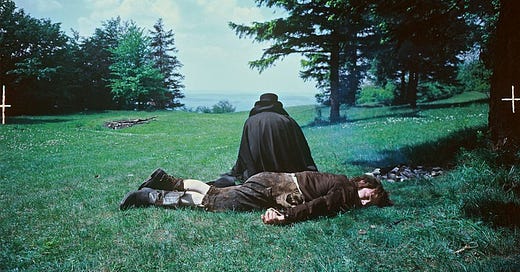Werner Herzog’s film The Enigma of Kaspar Hauser tells of a boy who has lived his first sixteen years in this world chained in an underground cellar. His only human contact is a cloaked man who feeds him, teaches him to scribble his name, to walk, to say a phrase or two, and then abandons him in an unnamed Bavarian town. The foundling emerges into bourgeois society from the blackest night and is subsequently arrested, mocked, studied, beaten, and worse.
In between those accountants’ truths, there is much tenderness, due largely to the careful performance by Bruno S, who plays Kaspar as a sort of Bizarro version of himself.1 His eyes manipulate the camera in captivating ways, and at times it seems as if his attention is orthogonal to the scene’s tension. Herzog’s casting made the reviewer John Simon criticize the film’s historical accuracy because the forty-year-old Bruno S. played the supposed sixteen-year-old Kaspar Hauser. Herzog responded: “Watch the film and witness genuine human suffering, not theatrical melodrama. Anyway, who cares about the man’s age? I’m a filmmaker, a storyteller, not an accountant of history. Whether Bruno was forty or seventy or fifteen years old isn’t important. Criticism like this comes from the knowledge that audiences bring with them, and has nothing to do with the film per se.”2
Kaspar Hauser contains many such Flaubertian exhortations against determined philistines, peddlers of human suffering, pedantic academics, and compulsive note-takers. At Kaspar’s autopsy the townspeople examine his cadaver with barely contained glee, for they can finally conduct their science experiment in full and in peace. They find that he has an enlarged liver and a malformed brain. “What a wonderful, what a precise report this will make!” says the scribe, “Deformities discovered in Kaspar Hauser’s brain and liver! Finally we have got an explanation for this strange man…” He jaunts away, happily missing the point.
There have been hundreds if not thousands of articles, books, and documentaries written and produced about Kaspar Hauser. They focus largely on his mysterious origins, the criminal case of his murder, and other quotidian matters. Among the scribes and the John Simons of this world, Werner Herzog and Bruno S. stand tall, daring to look into the soul of a poet without attempting to explain it.
Werner Herzog on Bruno S:
When he was four years old, his mother, a prostitute, beat him so hard he lost his speech and used this as a pretext to put him into an asylum for retarded and insane children. Bruno told me about his time in an institution during the Nazi era, something he talks about in Stroszek, the second film we made together. […] Eventually, at the age of nine, he escaped and spent the next twenty-three years of his life in and out of institutions and prisons. […]
Bruno was aware that the film we made together was as much about how society had destroyed him as it was about how society had killed Kaspar Hauser. Maybe for this reason he wanted to remain anonymous, and for many years I called him the “Unknown Soldier of Cinema.” The Enigma of Kaspar Hauser is his monument; I even considered calling the film The Story of Bruno Hauser.
Despite this line, Herzog seems to respect John Simon:
Some reviewers—like John Simon—have hated almost all my films, but that’s okay. I never minded Simon dunking me underwater for as long as he could, and actually like him for his hostility and all-pervading vitriol. He is dismissive of a film from beginning to end. The man is not apathetic.
Both quotes are from A Guide for the Perplexed: Conversations with Paul Cronin, an indispensable source of Herzogiana.




